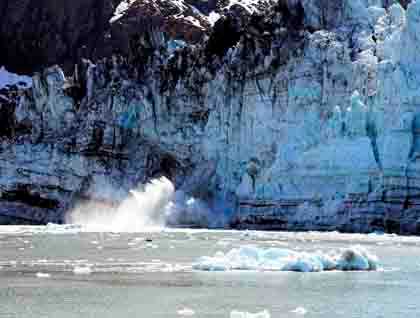Wolves and glaciers and bears- oh my! Our Glacier Bay National Park expedition has been filled to the brim with the sights and sounds of this wilderness place. Sounds, sights and yes, the smells of South Marble Island greeted us right after breakfast. Low growls from Steller sea lion bulls draped across the rocks like Jabba the Hut, bright white black-legged kittiwakes swooped and called along the cliffs, the breath of humpback whales hung in the clear air and tufted puffins were flying everywhere. It’s busy here in the warming spring as mating and nesting for several species of seabirds is in full swing. Scanning the cliffs and beaches brought more bird species and some high mountain goat sightings, though the windfall came a bit later in Tidal Inlet.
Someone cried out ‘wolf’ and instantly the bow was filled with binoculars and excitement. Right down at water level a tawny lone wolf was foraging, much like coastal bears forage – turning over rocks and digging into the low tide larder; perhaps he/she was finding crab or gunnels (small eel-like fish) left by the outgoing tide. Though wolves are certainly an important part of this ecosystem, actually seeing them is rare, and spending more than thirty minutes watching that wild and beautiful top predator search for food was extraordinary.
Our small vessel easily fit through Russell Cut, a narrow slice of water known to be rich in wildlife sightings…soon some sharp eyes spotted a large brown bear, most likely a boar, busily browsing on the newly sprouted grass and sedges at the edge of the intertidal on Russell Island’s eastern shore. Coastal brown bears are large omnivores, evolved from carnivores to eating about a 50% vegetable diet today; the opposite path of humans as we have moved from primarily herbivores to a more carnivorous lifestyle.
As we sailed ever northward toward the 15,000-foot Fairweather mountains, the bluish white icy mass of Margerie Glacier hove into view in the upper end of Tarr Inlet. Eventually our fair little ship stopped in front of the wall of ice and we watched and waited and willed it to calve. There was much “white thunder”; the great crackling voice of the glacier and several impressive calving events as this stable glacier drops six to eight feet of ice off its mile-long face every day.
Embraced by another sunny day and accompanied by ranger Janine Driscoll and Tlingit cultural interpreter Alice Haldane, this jewel of our National Park system truly exceeded all our expectations!







